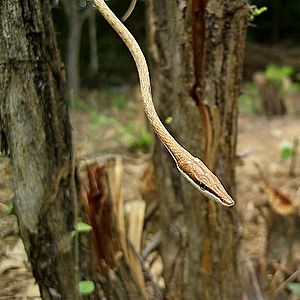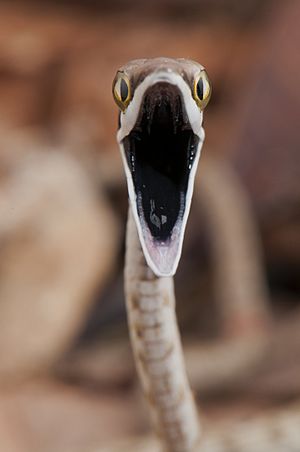Mexican vine snake facts for kids
Quick facts for kids Oxybelis aeneus |
|
|---|---|
 |
|
| Conservation status | |
| Scientific classification | |
| Genus: |
Oxybelis
|
| Species: |
aeneus
|
| Synonyms | |
The Oxybelis aeneus, also known as the Mexican vine snake or brown vine snake, is a type of snake. It belongs to the colubrid family. This snake is special because it is native only to the Americas.
Contents
Where the Mexican Vine Snake Lives
The Mexican vine snake, O. aeneus, can be found in many places. It lives from southern Arizona in the United States, all the way through Mexico, and down to northern South America. You can also find it on the islands of Trinidad and Tobago.
What the Mexican Vine Snake Looks Like
The Mexican vine snake is a very thin snake. It can grow up to about 6 feet (1.9 meters) long. This length includes its very long tail. Its color can change from gray to brown, and its belly is usually yellow.
Its body is flat on the sides, like a leaf. The snake has a long, pointed nose that is more than twice as long as its eye. It has smooth scales on its back. These scales are arranged in 17 rows around the middle of its body.
Other Names for the Snake
In Arizona, people sometimes call O. aeneus the "pike-headed tree snake." In Trinidad and Tobago and Guyana, it is known as a "horse whip" or "vine snake."
How the Mexican Vine Snake Behaves
This snake spends most of its time in trees. It is active during the day. Because it is so thin and often stays still, people sometimes mistake it for a vine. If the snake feels threatened, it might release a bad-smelling liquid from its body to scare away predators.
What the Mexican Vine Snake Eats
The Mexican vine snake mainly eats lizards. However, it also enjoys eating frogs and small birds.
Is the Mexican Vine Snake Dangerous?
The Mexican vine snake has a mild venom. It has fangs at the back of its mouth. But don't worry, it is not considered dangerous to humans. If you get bitten, it might cause a small itching feeling, but nothing serious.
Reproduction and Life Cycle
The Mexican vine snake lays eggs. This means it is an egg-laying animal. Usually, a female snake lays about 3 to 6 eggs at a time. In Arizona, the baby snakes usually hatch from their eggs in September.
- Species Oxybelis aeneus at The Reptile Database
See also
 In Spanish: Bejuca para niños
In Spanish: Bejuca para niños



